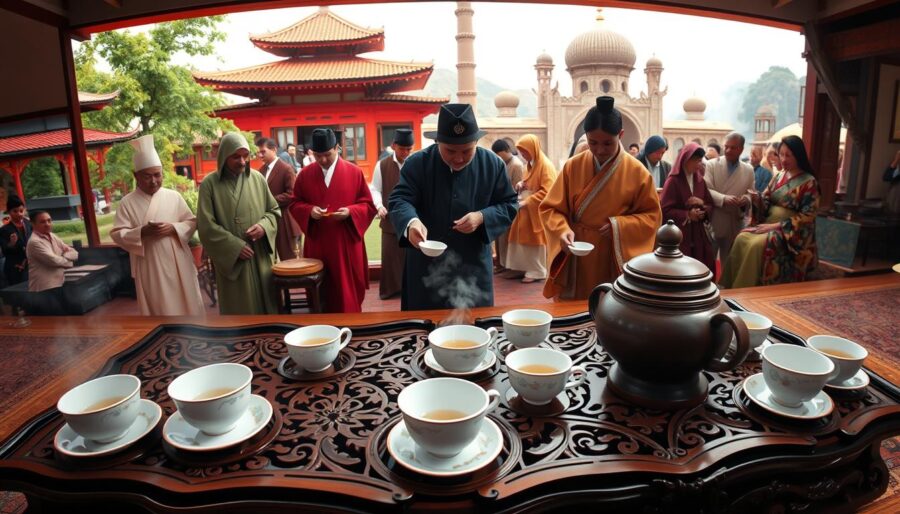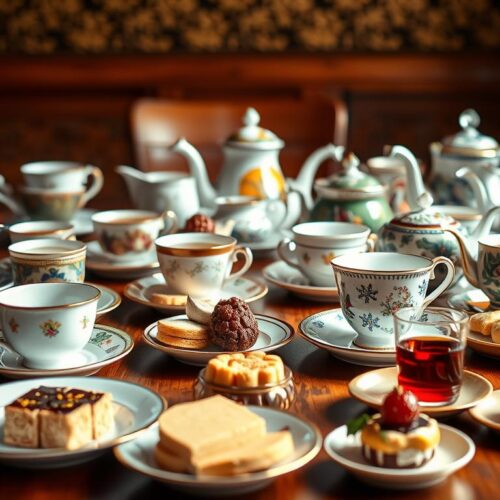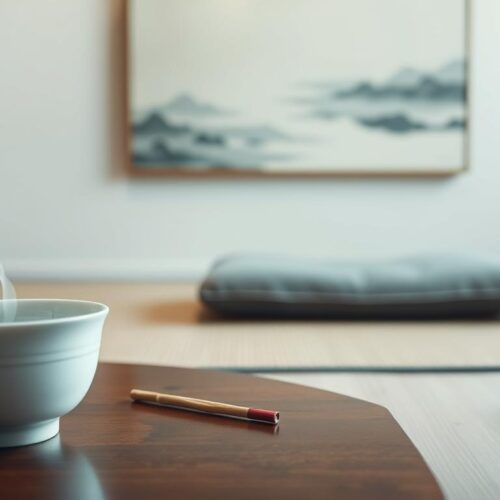Tea is much more than a drink. It symbolizes culture, connection, and heritage. Exploring tea rituals reveals how a simple leaf becomes a deep ceremony. It shows the essence of togetherness and celebration.
From the grace of Japan’s tea ceremony to Morocco’s communal tea times, each tradition highlights tea’s role worldwide. These practices show our love for joy and mindfulness in a cup. Tea is not just a drink, but a loved art form.
The Historical Significance of Tea Rituals
Tea’s historical significance is huge. It’s become a big part of societies worldwide for centuries. It started with ancient rituals. Now, tea represents a rich cultural heritage. You’ll see it’s key in social and spiritual events, promoting hospitality, respect, and mindfulness.
In China, tea ceremonies go beyond just drinking. They include a meditative side that helps people connect. The British afternoon tea, meanwhile, is a social event. It’s about elegance and refinement. Both traditions show tea’s big impact on culture and how people interact.
Around the world, the cultural heritage of tea is kept alive, showing unique historical stories. Tea rituals are more than a drink. They’re about shared history and enriching social moments. Learning about these rituals lets us see the values important to different cultures.
Iconic Tea Rituals Across Asia
Asia’s tea culture is rich and varies greatly from place to place. It showcases rituals that are both traditional and social. Every region has its own special way, showing us the heart of its people.
The Japanese tea ceremony, or Chanoyu, is deeply rooted in ceremony and mindfulness. It is inspired by Zen Buddhism’s principles, like harmony and respect. This ceremony turns making matcha into a moment of meditation, celebrating simplicity and beauty.
On the other hand, the Chinese Gongfu Cha highlights the art of making tea. It uses exact steps and several quick steeps. This brings out the best flavors of oolong and green tea. It’s a way to bring people together, showing skill, patience, and respect for tea.
The Indian chai ritual is a daily practice of warmth and community. Every family has their own special mix of spices and tea. This creates a welcoming drink that is full of heart. Chai is less formal but is a key part of social life, symbolizing togetherness and comfort at home.
Tea Traditions in the Middle East
The Middle East loves its tea traditions, which are key at social events and for making connections. Moroccan mint tea is at the heart of it all, mixing green tea, fresh mint, and sugar to show hospitality. When someone pours the tea from up high, it makes a spectacle that brings people together and sparks friendly chats.
Turkish tea ceremonies, on the other hand, give us a peek into relaxed hangouts. They use a special teapot called a Çaydanlık to brew the tea just right. The tea is then served in pretty, tulip-shaped glasses. This not only looks good but makes the tea taste better. Moroccan and Turkish teas mix tradition, culture, and warmth, welcoming us all to enjoy their deep flavors.
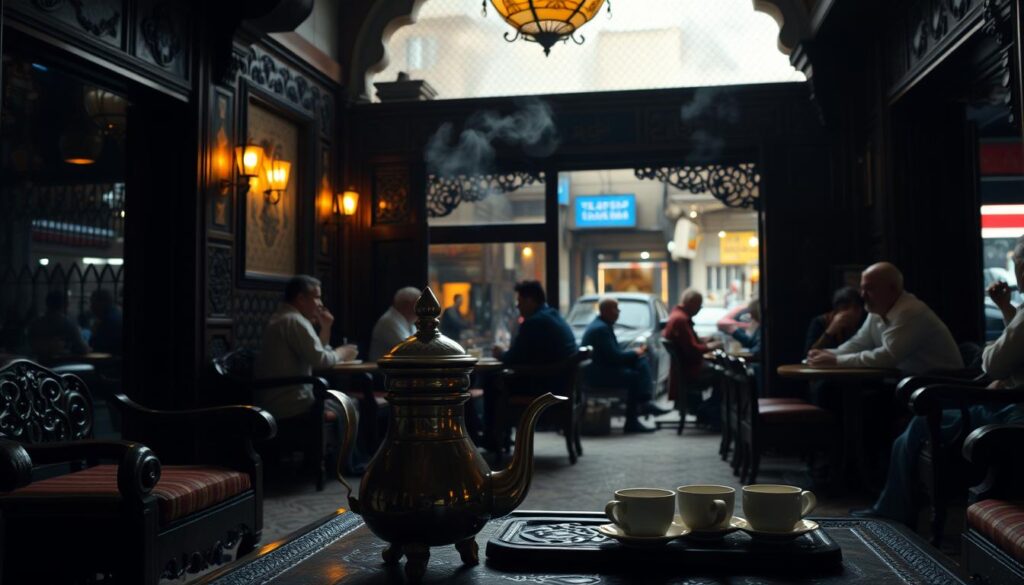
| Feature | Moroccan Mint Tea | Turkish Tea Ceremonies |
|---|---|---|
| Tea Base | Green tea | Black tea |
| Main Ingredients | Fresh mint, sugar | Water, sugar (optional) |
| Preparation Method | Poured from a height for effect | Double stacked kettle (Çaydanlık) |
| Serving Style | Communal, traditional | Individual tulip-shaped glasses |
| Cultural Significance | Symbol of hospitality and generosity | Represents leisurely conversations |
The Art of British Afternoon Tea
The tradition of British afternoon tea started in the 1840s. It’s known for its elegance and grace. Held between 3:30 and 5 PM, it offers a break from daily tasks. You’ll enjoy premium teas with pastries, scones, and sandwiches.
Knowing about tea customs in England helps you enjoy this tradition more. Afternoon tea is more than just tasty. It’s a chance to chat and connect with others in a classy setting.
Exploring different teas and snacks lets you partake in a special ritual. British afternoon tea is about more than just eating. It’s a time for warmth and friendship, making everyday moments special.
Tea Practices in Africa
African tea traditions showcase the continent’s rich cultural diversity and sense of community. Chai is a beloved drink in Africa, often made with many spices. It warms the body and helps people feel connected to each other.
In different parts of Africa, tea rituals vary, reflecting each community’s unique culture. For example, in Ethiopia, while coffee ceremonies are important, tea is also a key part of social events. In Morocco, serving green tea with mint to guests is a way to show hospitality and friendship.
Sharing chai in Africa is a way for people to come together. The way people make tea can differ, with some using an open flame and others using modern methods. But no matter how it’s made, sharing tea helps strengthen bonds among people all over the continent.
Unique Tea Customs in the Americas
The Americas are rich in diverse tea customs. Each one reflects the area’s cultural mix. In Argentina, yerba mate has become more than just a drink. It’s a way people come together, sharing it from a gourd through a metal straw.
This tradition means a lot. It shows friendship and trust when people pass the mate around. The act of sharing builds community. This turns drinking tea into a powerful social act.
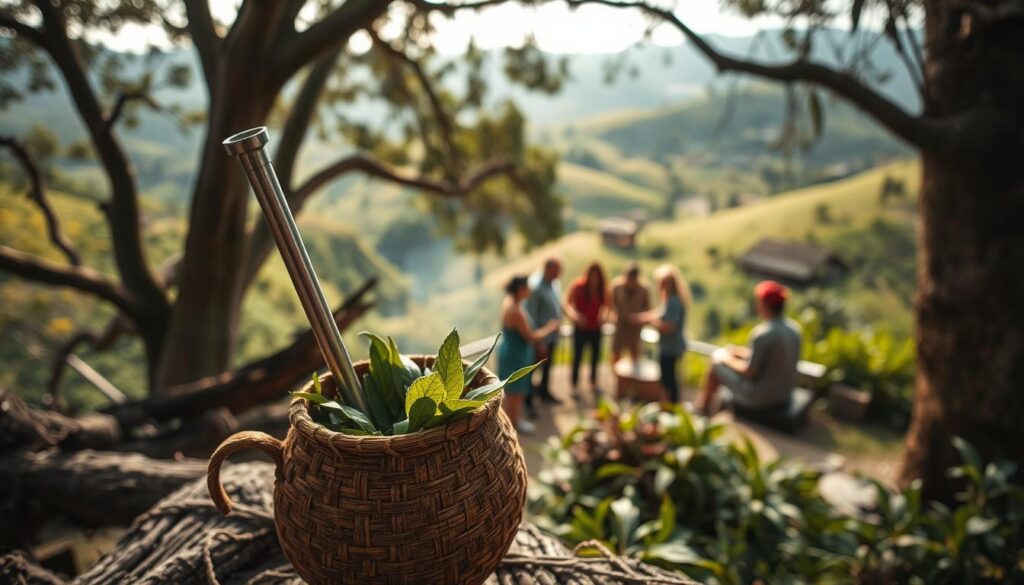
Tea traditions vary greatly across the Americas, shaped by each area’s people and history. Indigenous groups, for example, have unique tea rituals. These rituals highlight the importance of the ingredients and how they’re prepared.
| Country | Tea Custom | Significance |
|---|---|---|
| Argentina | Yerba Mate | Symbol of friendship through shared experiences |
| Brazil | Chimarrão | Similar communal sharing through a gourd |
| Peru | Herbal Infusions | Connection to indigenous healing traditions |
| Mexico | Té de Flores | Celebration of local flowers and flavors |
The tea customs in the Americas are not just about taste. They also celebrate the communities’ rich histories and values. Getting to know these customs shows how important they are in people’s lives.
Modern Tea Culture and Its Evolution
In recent years, tea culture has changed a lot. Traditional ways now mix with new ideas, thanks to worldwide influences and tech advances. When looking into tea’s evolution, you’ll see a market full of different teas. They appeal to many tastes while keeping the deep history of tea alive.
Tea’s commercial growth has brought new flavors and experiences. Brands offer fusion teas that mix old herbs with new styles. This draws in the young crowd and helps them value tea’s long history.
How we make tea has also changed. You can find single-serve bags and top-notch loose leaves. This makes it easy to have tea anywhere. Cold brews and matcha lattes show how today’s tea fits our lives and likes.
Yet, the interest in old tea rituals is coming back. Many people enjoy ceremonies that show the beauty of making tea. This connects the past and present, showing how tea rituals have grown. It also invites new people to enjoy this age-old tradition.
| Aspect | Traditional Practices | Contemporary Trends |
|---|---|---|
| Preparation Method | Loose leaves, teapots | Tea bags, cold brew |
| Popular Varieties | Green, black, oolong | Flavored, fusion, herbal |
| Consumption Style | Ceremonial | Convenient, casual |
| Audience | Traditionalists | Millennials, Gen Z |
The modern world of tea lets us explore and value our drink choices. As you delve into this changing scene, you’ll find ways to connect with both new trends and old ways. This mix makes your tea journey richer, giving you a better grasp of its role today.
Health Benefits and Mindfulness in Tea Drinking
Tea is not just a drink. It brings a lot of health perks that better your well-being. It’s packed with antioxidants. These help your heart stay healthy and boost your mental focus and calm. Making tea a part of your day is an easy way to care for yourself.
Drinking tea mindfully helps you slow down and savor now. This tiny ritual can make a calm space in your day. It helps lower your stress, giving you energy to face what comes.
Tea traditions teach us to live in the moment. By following these, you learn more about nature and your role in it. As you learn about tea’s health benefits, think about how these habits help both your body and mind. This way, tea wellness becomes a key part of your life.
Embracing Global Tea Traditions at Home
Bringing tea rituals home lets you dive into the world’s tea culture. You can choose different teas, like Japanese Matcha, Indian Chai, or English Breakfast. Each one has its own taste and way to make it, turning your tea time into an adventure without leaving the kitchen.
Adding tea traditions to your life is simple. You might throw an afternoon tea party in the British style with scones and teas. Or, try a Chinese Gongfu tea ceremony, where you focus on brewing tea perfectly. Either way, these practices boost your joy and help you appreciate their origins more.
Exploring tea traditions helps you connect with a global community. Embrace changing these customs to fit your home, turning it into a place to discover and enjoy tea’s diversity. Making these traditions part of your day enriches your taste and your knowledge of tea worldwide.

